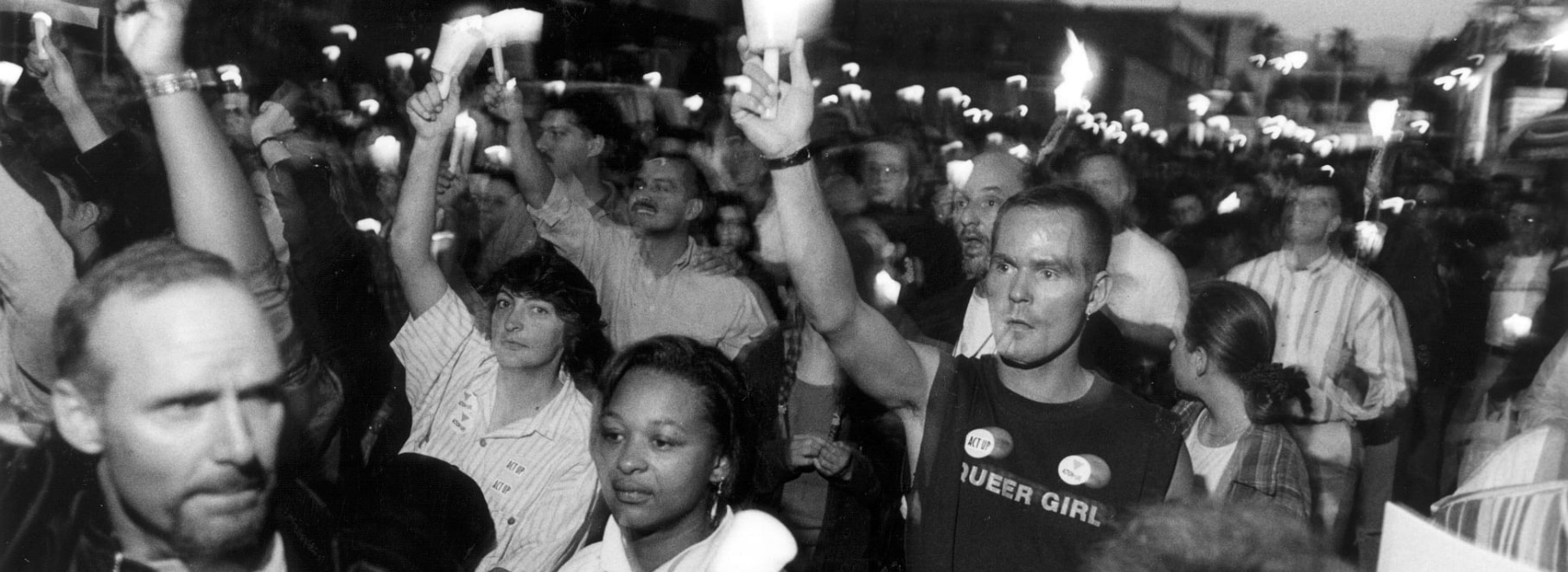Realizing that funds were needed to educate the community and prevent the spread of the disease, the founders enlisted the help of other friends (who became many of APLA’s early volunteers) and held a Christmas benefit. The party raised more than $7,000, which became the seed money for a new organization. Recognizing that AIDS was not just a gay disease, the founders named the organization AIDS Project Los Angeles. The first board of directors was elected on January 14, 1983.
Realizing that funds were needed to educate the community and prevent the spread of the disease, the founders enlisted the help of other friends (who became many of APLA’s early volunteers) and held a Christmas benefit. The party raised more than $7,000, which became the seed money for a new organization. Recognizing that AIDS was not just a gay disease, the founders named the organization AIDS Project Los Angeles. The first board of directors was elected on January 14, 1983.
West Hollywood Memorial Walk
Aid for AIDS partners with the City of West Hollywood to unveil Tribute to Life/West Hollywood Palms (later renamed West Hollywood Memorial Walk) on Santa Monica Boulevard between Fairfax Avenue and Doheny Drive. Bronze plaques pay tribute to lives lost to HIV/AIDS.
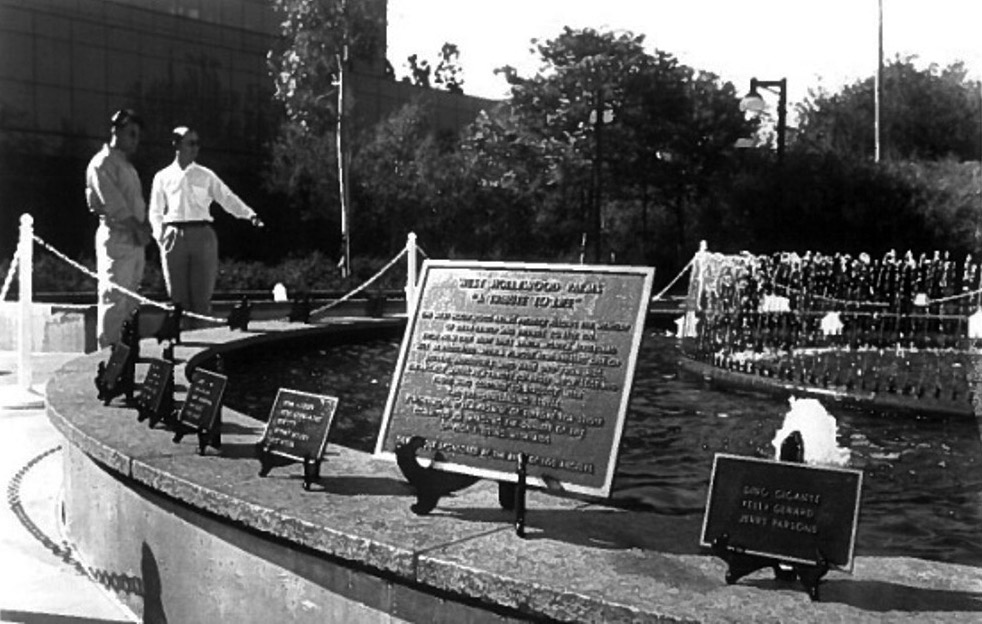
Disturbing Trends
Disturbing new trends became apparent in the AIDS epidemic in the early ‘90s. Incidence of infection among communities of color rose sharply, and numbers of infected women also grew. Mortality due to AIDS was at its highest ever.
The number of new client registrations at APLA soared. The agency registered as many new clients between 1992 and 1995 as were registered in the previous eight years.
As APLA settled into its new facility on Vine Street, reports emerging from the ninth International Conference on AIDS in Berlin in 1993 shattered hopes that HIV infection could be managed successfully by early intervention with existing antiretrovirals.
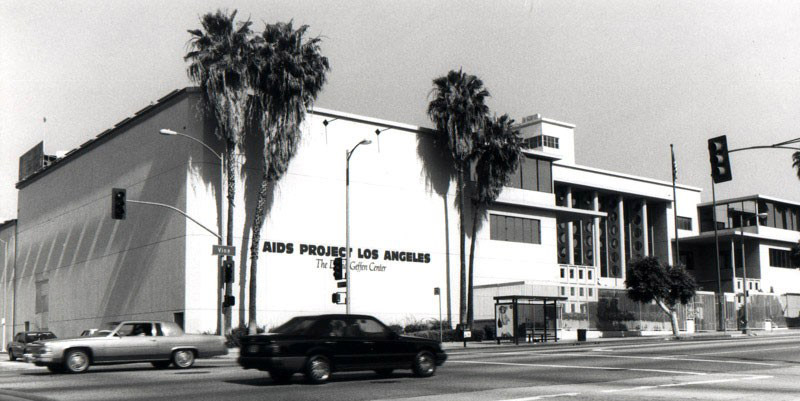
Realizing that funds were needed to educate the community and prevent the spread of the disease, the founders enlisted the help of other friends (who became many of APLA’s early volunteers) and held a Christmas benefit. The party raised more than $7,000, which became the seed money for a new organization. Recognizing that AIDS was not just a gay disease, the founders named the organization AIDS Project Los Angeles. The first board of directors was elected on January 14, 1983.
New Challenges
In 1995, 2,407 new clients were registered at APLA, the highest level ever. By October 31, 500,000 cases of AIDS had been reported in the United States.
A Turning Point
Optimistic reports began to appear that year, when the first protease inhibitor, Invirase, was made available outside of clinical trials. Before year’s end, this new drug, part of the second class of HIV drugs, was approved by FDA.
In the next few years, Invirase and other members of its class would help prolong the life expectancy of people living with HIV and establish a new paradigm for the AIDS epidemic.
Realizing that funds were needed to educate the community and prevent the spread of the disease, the founders enlisted the help of other friends (who became many of APLA’s early volunteers) and held a Christmas benefit. The party raised more than $7,000, which became the seed money for a new organization. Recognizing that AIDS was not just a gay disease, the founders named the organization AIDS Project Los Angeles. The first board of directors was elected on January 14, 1983.
Optimism
The sense of hope was bolstered by an unmistakable downward trend in AIDS mortality. The annual death rate dropped for the first time in 1996, and that trend continued in subsequent years.
Optimism about combination therapy had a powerful impact at APLA. Client caseloads rose, and all APLA programs experienced increased demand, and in some cases, access to programs became based on degree of need.
At the forefront of new services at APLA was the Work Services Program. As more people with HIV considered resuming their careers, APLA was prepared to assist them with the challenge.
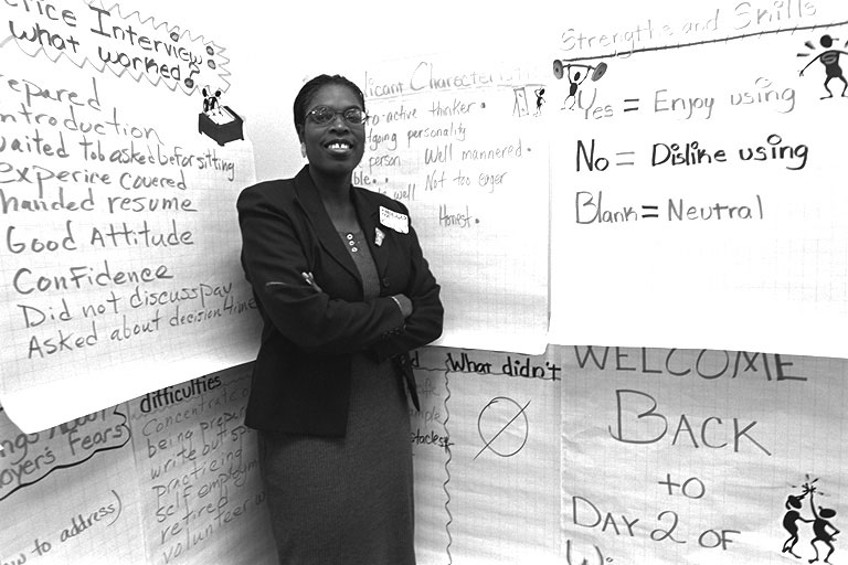
Uneven Progress
A new third class of drugs — NNRTI’s, or the so-called HAART therapy — and the first viral load test to determine the level of HIV in the body are released.
AIDS is no longer leading cause of death for all Americans ages 25-44, although it remains the leading cause of death for African Americans in this age group. In Los Angeles, HIV was now a disease of the poor regardless of their color, and of people of color regardless of their income.
Realizing that funds were needed to educate the community and prevent the spread of the disease, the founders enlisted the help of other friends (who became many of APLA’s early volunteers) and held a Christmas benefit. The party raised more than $7,000, which became the seed money for a new organization. Recognizing that AIDS was not just a gay disease, the founders named the organization AIDS Project Los Angeles. The first board of directors was elected on January 14, 1983.
APLA Expands
From 2001 to 2003, APLA moved closer to its client populations, opening food pantries in South Los Angeles and Long Beach. The agency also moved its main offices to the David Geffen Center on Kingsley Drive, with a new site for the APLA Dental Clinic on Wilshire Boulevard in the Samaritan Medical Tower.
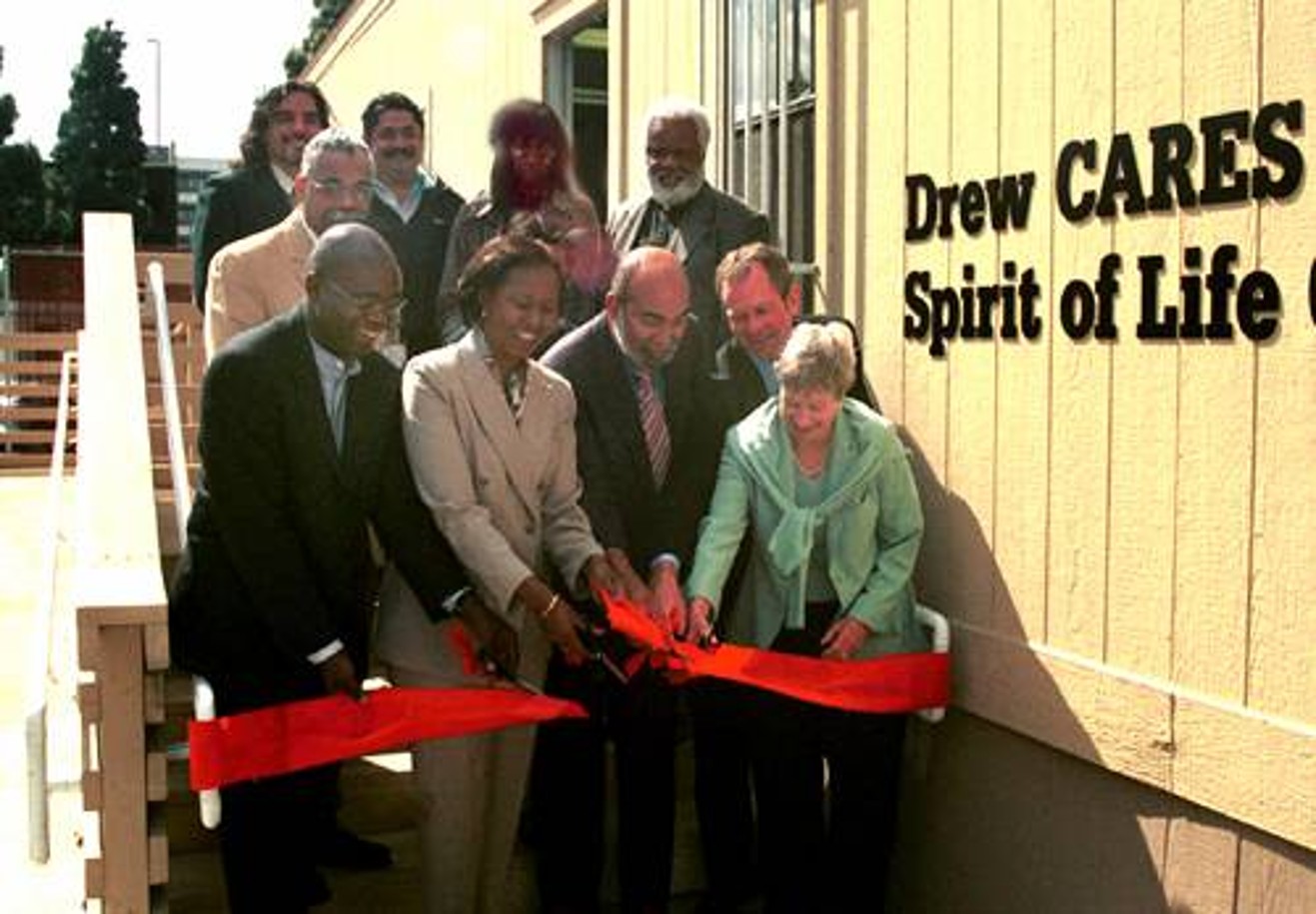
Twenty Years of AIDS
Twenty years after the publication of a report describing unusual infections in otherwise healthy gay men, one million Americans were infected with HIV. Over 40,000 new infections were occurring annually. And every country and continent was feeling the devastating impact of HIV.
After generic drug manufacturers pledge to produce low-cost versions of HIV/AIDS medications for developing countries, several major pharmaceutical companies respond by further lowering their prices—expanding access to life-saving treatment for those in need.
Realizing that funds were needed to educate the community and prevent the spread of the disease, the founders enlisted the help of other friends (who became many of APLA’s early volunteers) and held a Christmas benefit. The party raised more than $7,000, which became the seed money for a new organization. Recognizing that AIDS was not just a gay disease, the founders named the organization AIDS Project Los Angeles. The first board of directors was elected on January 14, 1983.
The Global Forum on MSM & HIV
By the end of 2005, APLA had begun its first international partnership, a project with India-based AIDS service provider YRG CARE. The initiative offered multilingual HIV care and prevention services to women in Tamil Nadu, one of India’s regions hit hardest by the epidemic.
APLA subsequently continued to expand its international efforts with an HIV prevention program for gay men in China; prevention, research, training, and advocacy efforts in Latin America; and a nutrition initiative in South Africa. In 2006, APLA became the secretariat to the Global Forum on MSM & HIV (MSMGF). Guided by a Steering Committee of 20 members from 17 countries around the world, MSMGF worked to promote MSM health and human rights worldwide through advocacy, information exchange, knowledge production, networking, and capacity building.
Hardest Hit
APLA began an HIV prevention partnership with In The Meantime, a gay black men’s group, in response to alarming rates of HIV in urban black gay men.
Gay men and communities of color were, and continue to be, markedly overrepresented among people living with HIV/AIDS. The reasons for this disproportionate impact thought to be related to socioeconomic issues such as poverty, lack of access to quality health care, high rates of un- and underemployment, and limited educational attainment.
Realizing that funds were needed to educate the community and prevent the spread of the disease, the founders enlisted the help of other friends (who became many of APLA’s early volunteers) and held a Christmas benefit. The party raised more than $7,000, which became the seed money for a new organization. Recognizing that AIDS was not just a gay disease, the founders named the organization AIDS Project Los Angeles. The first board of directors was elected on January 14, 1983.
AHH is Formed
Aid for AIDS merges with the Serra Project to create Alliance for Housing & Healing (AHH).
South Los Angeles
APLA continued to expand on its commitment to serve the diverse South Los Angeles community. In 2009, the agency opened its S. Mark Taper Foundation Center, a freestanding dental clinic and food pantry on the Martin Luther King Jr.-Charles Drew University campus in South Los Angeles.
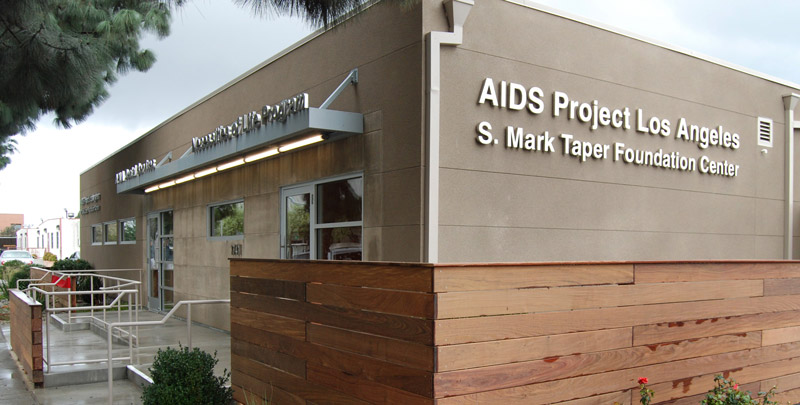
Federal Support
Newly elected President Barack Obama takes a bold step in the fight against HIV/AIDS by calling for the creation of the first-ever National HIV/AIDS Strategy for the United States.
At the global level, he launches the Global Health Initiative (GHI), a six-year, $63 billion effort to transform healthcare in low- and middle-income countries. Central to this initiative is the President’s Emergency Plan for AIDS Relief (PEPFAR), reinforcing the U.S. commitment to combating the HIV/AIDS epidemic worldwide.
Realizing that funds were needed to educate the community and prevent the spread of the disease, the founders enlisted the help of other friends (who became many of APLA’s early volunteers) and held a Christmas benefit. The party raised more than $7,000, which became the seed money for a new organization. Recognizing that AIDS was not just a gay disease, the founders named the organization AIDS Project Los Angeles. The first board of directors was elected on January 14, 1983.
APLA Health & Wellness Center
In 2011, APLA opens the APLA Health & Wellness Center in Baldwin Hills, bringing together HIV prevention services, economic development programs and social activities for gay and bisexual men and transgender individuals of color.
PrEP: A Biomedical Strategy Emerges
In July, groundbreaking research reshapes HIV prevention. A new CDC study and the Partners PrEP trial provide the first compelling evidence that a daily oral dose of the antiretroviral drugs already used to treat HIV can also significantly reduce the risk of infection in uninfected individuals exposed through heterosexual sex.
A week later, scientists announce game-changing results. Two studies confirm that individuals taking daily antiretroviral drugs experienced infection rates more than 60% lower than those on a placebo, marking a major advancement in the fight against HIV.
Realizing that funds were needed to educate the community and prevent the spread of the disease, the founders enlisted the help of other friends (who became many of APLA’s early volunteers) and held a Christmas benefit. The party raised more than $7,000, which became the seed money for a new organization. Recognizing that AIDS was not just a gay disease, the founders named the organization AIDS Project Los Angeles. The first board of directors was elected on January 14, 1983.
New Services
In April, APLA expands health services by implementing STD screening and treatment at the Health & Wellness Center.
Federally Qualified Health Center
In the fall, APLA Health & Wellness is awarded a federal New Access Point grant by the Health Resources Services Administration (HRSA) and becomes a federally qualified health center focusing on healthcare services for low-income LGBT people.
Realizing that funds were needed to educate the community and prevent the spread of the disease, the founders enlisted the help of other friends (who became many of APLA’s early volunteers) and held a Christmas benefit. The party raised more than $7,000, which became the seed money for a new organization. Recognizing that AIDS was not just a gay disease, the founders named the organization AIDS Project Los Angeles. The first board of directors was elected on January 14, 1983.

